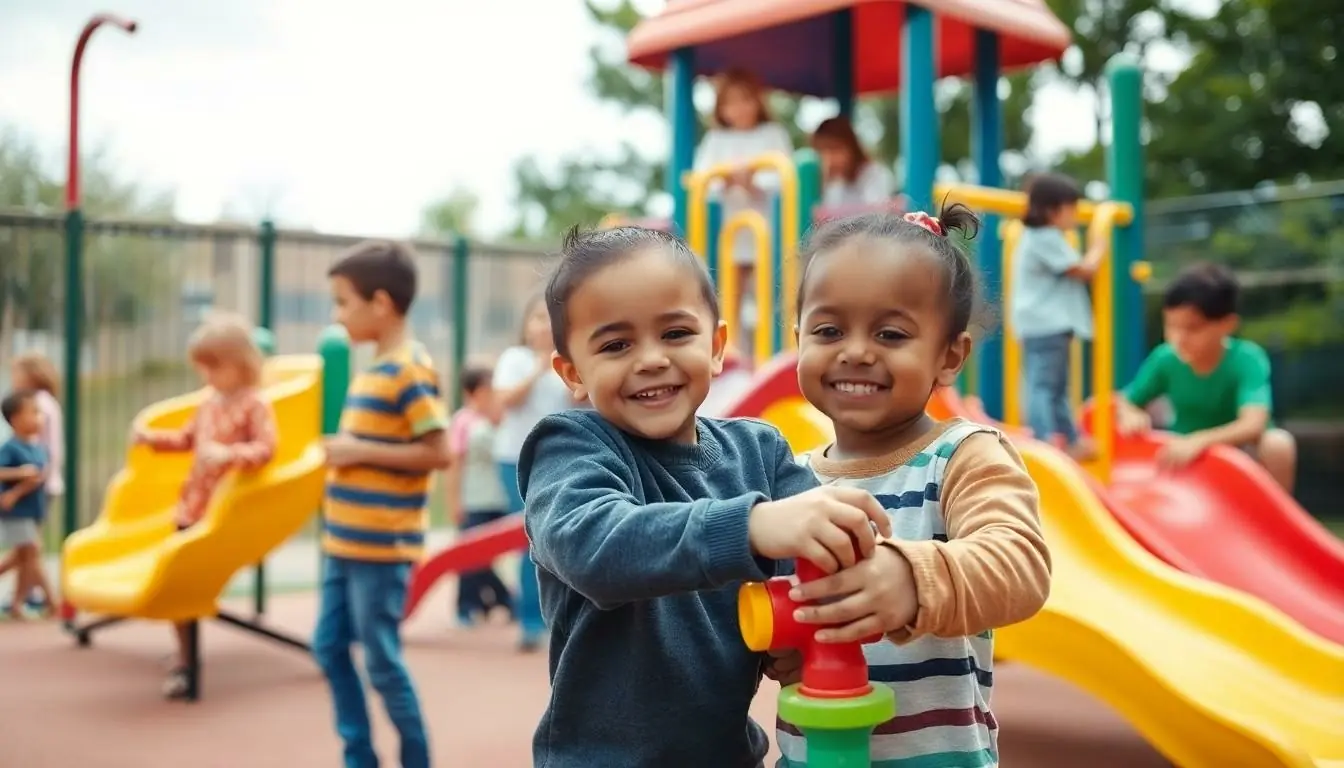Table of Contents
ToggleDisciplining a child can feel like navigating a minefield while blindfolded. Parents often wonder if they should channel their inner drill sergeant or take a more laid-back approach. The truth is, there’s no one-size-fits-all solution. What works for one child might send another into a dramatic meltdown worthy of an Oscar.
Finding the best way to discipline involves a mix of strategy, patience, and a sprinkle of humor. After all, who said parenting can’t be a little fun? In this article, we’ll explore effective methods that balance authority with compassion, turning those “oops” moments into valuable life lessons. Get ready to discover the art of discipline that not only corrects behavior but also strengthens the bond between parent and child.
Understanding Discipline
Discipline involves guiding behavior and fostering responsibility. It’s essential to view discipline as a teaching tool rather than mere punishment. Balancing authority with empathy creates a supportive environment for children to learn from their mistakes. Effective discipline methods encourage children to reflect on their actions and understand the consequences.
Positive reinforcement plays a significant role in discipline. Rewarding desired behaviors builds self-esteem and motivates children to repeat those actions. Setting clear boundaries helps children recognize expectations and promotes a sense of security. For example, enforcing consistent rules regarding screen time or homework responsibilities instills structure in daily routines.
Natural consequences contribute to effective discipline. Allowing children to experience the outcomes of their choices teaches valuable lessons. If a child refuses to wear a coat on a chilly day, feeling cold can emphasize the importance of dressing appropriately. However, parents should intervene in situations where safety is at risk, ensuring a balanced approach.
Communication remains vital in the discipline process. Active listening fosters an open dialogue, allowing children to express their feelings. By discussing behaviors and their effects, parents can guide children toward better decisions. Questions like “What choice led to this outcome?” encourage self-reflection.
Lastly, consistency strengthens the impact of discipline. Regularly applying rules reinforces their significance and helps children internalize expectations. Disparate responses can lead to confusion, undermining discipline efforts. Establishing a routine empowers both parents and children to navigate the discipline journey effectively.
Types of Disciplinary Methods
Different disciplinary methods serve unique purposes in guiding children’s behavior. Each approach fosters understanding and learning in distinct ways.
Positive Reinforcement
Positive reinforcement focuses on highlighting and rewarding desired behaviors. Parents can offer praise or small rewards when children exhibit good conduct. Such recognition boosts a child’s self-esteem and encourages them to repeat those behaviors. This method creates a supportive environment, allowing children to associate positive actions with rewards. It’s crucial to be specific in praise, making sure children understand what actions earned the recognition. For example, saying “I appreciate how you helped your sibling” helps clarify the desired behavior.
Time-Out Techniques
Time-out techniques allow children to take a break from overwhelming situations. This method provides a calm space for children to reflect on their actions. It helps them regain composure and think through their behavior. The time-out should last for a duration based on the child’s age, with one minute per year being a common guideline. Consistency in applying time-outs reinforces the message behind this technique. Parents also benefit by modeling patience and emotional regulation during these moments.
Natural Consequences
Natural consequences focus on allowing children to experience the results of their actions. When children forget their jacket, letting them feel cold teaches responsibility for personal belongings. This method emphasizes learning from mistakes rather than offering immediate interventions. Ensuring safety is paramount; parents should assess risks before allowing natural consequences. Allowing children to face outcomes promotes critical thinking and helps them make more informed choices in the future.
The Importance of Consistency
Consistency strengthens discipline practices. It ensures children understand expectations and learn appropriate behaviors. They feel secure when boundaries remain stable.
Setting Clear Boundaries
Clear boundaries form the foundation of effective discipline. Parents communicate acceptable behaviors and unacceptable actions through specific rules. Examples include curfews, screen time limits, and chores. Children need to know what behavior is expected. Frequent reminders solidify these boundaries. Consistent application reduces confusion and frustration.
Following Through with Consequences
Following through with consequences reinforces accountability. Parents must apply consequences consistently when rules are broken. Immediate consequences help children make connections between actions and outcomes. They learn valuable lessons through this process. For example, if a child misses curfew, they may lose privileges for a week. Following through maintains trust and credibility. Children recognize that parents are serious about expectations.
Cultural Influences on Discipline
Cultural factors deeply shape discipline practices across various societies. Different cultures prioritize distinct values that influence child-rearing approaches. In collectivist cultures, for example, obedience and respect for authority hold significant importance, leading to more authoritarian discipline techniques. Conversely, individualistic cultures often emphasize self-expression and autonomy, resulting in more permissive strategies that promote dialogue and negotiation.
Parenting styles can vary even within the same culture based on socio-economic backgrounds. Families with limited resources may adopt stricter discipline techniques as a response to external stressors. Research indicates that such environments often rely on immediate consequences to manage behavior effectively.
Communication styles also impact how children perceive discipline. In cultures that encourage open dialogue, children are often more involved in discussions about consequences. This engagement fosters understanding and responsibility. On the other hand, cultures that value silence may lead to children viewing discipline as a unilateral experience rather than a collaborative learning opportunity.
Religious beliefs contribute to preferred disciplinary methods as well. Certain faiths endorse specific teachings concerning respect and obedience, shaping parents’ choices around discipline. Additionally, cultural rituals and traditions may provide frameworks for teaching values and behaviors, reinforcing discipline through familiar community practices.
Understanding the cultural context surrounding discipline aids in addressing children’s behavior more effectively. Successful discipline approaches integrate cultural values and practices to create a tailored experience. It is essential for parents to reflect on their cultural backgrounds while navigating their child’s unique temperament and developmental stages. Such awareness fosters an effective discipline strategy aligned with both cultural influences and individual needs.
Expert Opinions and Research Findings
Experts emphasize the importance of understanding that effective discipline relies on a child’s individual temperament and needs. According to a study by the American Academy of Pediatrics, fostering a nurturing environment helps children learn self-discipline and encourages positive behavior. Research indicates that positive reinforcement significantly boosts self-esteem, making rewards for desired behaviors a crucial component in discipline strategies.
The role of natural consequences surfaces frequently in discussions about discipline practices. Allowing children to face the outcomes of their actions can cultivate critical thinking skills. Many child development specialists advocate for this approach, asserting that it fosters a sense of responsibility in children.
Communication remains a cornerstone in the discipline process. Engaging in active listening allows children to express their feelings and understand their choices better. Open dialogue is shown to strengthen the parent-child bond, making children more receptive to guidance.
Consistency emerges as another vital aspect of effective discipline methods. Studies suggest that children thrive in environments where rules are clear and consistently enforced. Parents are encouraged to communicate boundaries explicitly, ensuring children understand expectations, such as bedtime and screen time limits.
Cultural influences significantly shape preferred disciplinary methods across different societies. Research shows that collectivist cultures often emphasize obedience and respect for authority, while individualistic cultures prioritize self-expression and autonomy. Understanding these cultural dynamics helps parents tailor their discipline strategies to align with both cultural values and the specific needs of their children.
Conclusion
Finding the best way to discipline a child requires a thoughtful approach that balances authority and compassion. By viewing discipline as a teaching tool rather than punishment parents can foster responsibility and growth in their children. Establishing clear boundaries and maintaining consistency are essential in helping children feel secure and understand expectations.
Incorporating positive reinforcement and natural consequences can promote critical thinking and self-esteem. Open communication allows for reflection and understanding of actions. Ultimately the journey of discipline is about nurturing a strong parent-child relationship while guiding children toward becoming responsible and empathetic individuals.








